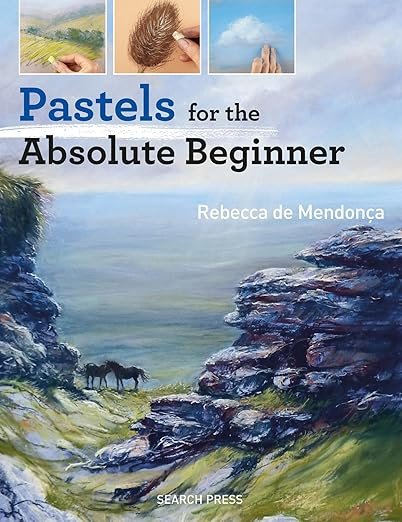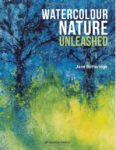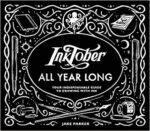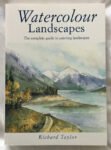This book keeps popping up on my Amazon recommendations. When I took a look inside,…

Pastels For The Absolute Beginner, Rebecca De Mendonça – Book Review
This book wasn’t a birthday present. it’s just that after getting all those pastels, I wanted to know how to use then before getting started and potentially embarrassing myself. I found a few potential books on Amazon but decided to go for this one as the demonstrations within it seemed to be focused on landscapes and people, which suits my plans. I’ve been disappointed in the past when wanting to know how to use oil pastels and coloured pencils. Will I have my better luck with soft pastels?
This is a 144 page paperback. We have about 15 pages of introduction, including materials and setting up a workspace. Then about ten pages on how to draw, just generally, not with pastels. Next it’s thirty pages on pastel techniques/mark making. Then on to specifics with forty pages on landscapes and thirty pages on figures, portraits and animals. Finally a handful of pages on composition and that’s us done. Let’s go through those sections.
The stuff on materials wasn’t that interesting to me, already having the pastels and paper in front of me but I can see how the advice would be useful if I’d gone for the book first and the gear later. I liked how Rebecca pointed that readers don’t have to go out and buy exactly the same brand and colour pastels as the ones she uses in the demos. After I read this, I took a quick look at the Amazon reviews and, yes, there are still people that feel like they have to use exactly the same pastels as the author. Sigh. On the other hand, I was disappointed to read that I might need Conte crayons or pastel pencils to include detail in my paintings. But I think I’ll just stick with either charcoal pencils or with sharp shards cut off the soft pastels. Because I have the ability to think.
We then have an introduction on how to draw, most of it illustrated using charcoal. I think Rebecca was always onto a loser here. You can’t teach someone to draw from scratch in twelve pages,.
Then we get to the bit I was most looking forward to: the section on mark making. This was excellent. Fully comprehensive, with exactly the right number of photos and with examples of where these techniques were used in paintings, which is a sneaky way to widen the advice from how to make a mark to what sort of marks to make where and when. This is the chapter where we see the first demonstrations.
Then we have the chapter on colour. It starts from the basics with the colour wheel but soon gets into interesting and practical device about how to create the illusion of space and distance in a landscape. Not just general advice but also tips very specific to soft pastels.
We’re about halfway through the book at this stage and most of the rest of it is the two chapters on painting landscapes and painting. Obviously there are demos and, as expected, a lot of the work here is about illustrating the lessons from earlier in the book. But there are lots more tips in these chapters, often between the demos, about how to draw trees, water, people, animals,… It’s not all revision: there’s plenty more in here that Rebecca can teach us.
Finally the book closes with four pages on “composition”, although one of these pages is actually about one point perspective. Again, I think Rebecca was onto a loser here with a subject which, if you’re going to discuss it, needs more time and space. If Rebecca had so little space to devote to composition, I reckon she’d have been better off dropping these compositional tips into the demos.
Demo–wise, there are eight full demos: two still life, four landscapes, a figure and a portrait. They’re all worded as instructions rather than demos but I’ll give Rebecca a pass here after she told us we don’t have to religiously copy her materials. They’re quite long and detailed but this is what us beginners need. And they didn’t feel repetitive.
I finished this book the day I received it and was left feeling that it had been quite a light read. But when I came to write up notes, I found I’d learned quite a lot from this one. Despite my misgivings in a couple of places where Rebecca glossed over things quickly, this book absolutely met my needs as a novice pasteller. It had all the essentials about mark making and lots of valuable starting advice on painting landscapes and people using pastels. I may not ever pick up this book again and I was thinking of giving it three palettes. But, no, the reason I won’t be picking this one up again is that the lessons within it have become firmly entrenched in me. I’d no sooner pick this up again than I would go to lessons on how to ride a bike. I’m going to surprise myself and give this one four palettes. If only there could be beginners’ books of this quality for all art media.
<Edit, a few months later: I would recommend following this one up quickly with the Robert Brindley book to fine tune the techniques learned here and to take a step up to the next level. Maybe even buy both books at the same time.>
🎨🎨🎨🎨
You can find this book and more reviews of it at Amazon UK here. As an Amazon Associate, I earn commission from qualifying purchases but this costs absolutely nothing extra to you.








Leave a Reply